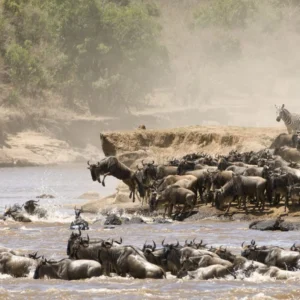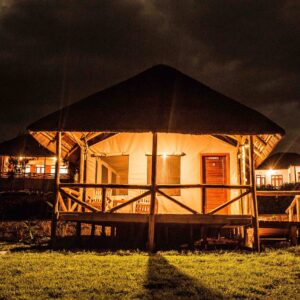Exploring the Stripes: Best Places to See Zebras in Tanzania
The African savanna would simply not be complete without the striking presence of the zebra. With their distinctive black and white stripes, these iconic equids are a ubiquitous and captivating sight, adding a unique visual rhythm to the vast landscapes of Tanzania. More than just beautiful, zebras are resilient grazers, highly social animals, and an integral part of the intricate ecosystem. Especially as key participants in the world’s greatest animal migration.
Tanzania, with its expansive national parks and conservation areas, offers unparalleled opportunities to witness these striped wonders in their natural habitat. From colossal herds stretching to the horizon to smaller, resident groups, here’s a guide to the best places to see zebras during your Tanzania safari.
1. Serengeti National Park: The Epicenter of Striped Herds
The Serengeti National Park is, without question, the premier destination for spotting zebras in Tanzania, and indeed, in Africa best places to see zebras in Tanzania. Zebras are an indispensable component of the Great Wildebeest Migration, with over 200,000 of them joining the millions of wildebeest on their annual journey across the plains. Why it’s a top spot. Their sheer numbers are staggering, especially during the migration best places to see zebras in Tanzania. You’ll see vast herds moving in unison, grazing, and interacting. The open grasslands provide excellent visibility. Allowing for incredible photographic opportunities of these striped masses. Whether it’s the calving season in the south or the dramatic river crossings in the north, zebras are a constant, vibrant presence. Key sightings. Colossal migratory herds, often mixed with wildebeest.
2. Ngorongoro Conservation Area: Abundance in the Crater
The Ngorongoro Conservation Area, particularly within the Ngorongoro Crater itself best places to see zebras in Tanzania. Offers incredibly consistent and close-up sightings of zebras. The crater floor’s lush, contained grasslands provide a year-round haven for a significant resident population of zebras that do not participate in the long-distance migration. Why it’s a top spot. Their high density within the crater makes them easy to spot, often seen grazing alongside wildebeest and other herbivores. The dramatic backdrop of the crater walls adds to the visual appeal of these striped beauties. Key sightings. Dense resident herds, often providing excellent photographic opportunities due to the open environment.
3. Tarangire National Park: Zebras Amidst Baobabs
Tarangire National Park, famous for its massive elephant herds and iconic baobab trees. Also boasts a healthy and easily observable population of zebras. During the dry season (June to October), as water sources become scarce elsewhere, zebras, along with other herbivores, congregate around the permanent waters of the Tarangire River. Why it’s a top spot. You’ll find large herds of zebras here, often mingling with wildebeest and elephants, creating diverse game-viewing scenes. The unique landscape, with its ancient baobabs, provides a picturesque setting for zebra sightings. Key sightings. Large herds, often seen near the Tarangire River in the dry season.
4. Lake Manyara National Park: Diverse Habitats, Striped Residents
Nestled beneath the dramatic Great Rift Valley escarpment. Lake Manyara National Park is a compact yet incredibly diverse park that includes open grasslands where zebras thrive. Why it’s a top spot. While not as numerous as in the Serengeti. Lake Manyara offers consistent sightings of zebras, particularly in the grassy areas near the lake and in the acacia woodlands. Their presence contributes to the park’s rich biodiversity. Might spot them alongside other unique species. Key sightings. Smaller resident herds within a diverse landscape.
5. Ruaha National Park: The Wild Southern Plains
Venturing into Tanzania’s Southern Circuit. Ruaha National Park is the country’s largest national park and offers a rugged, wild, and uncrowded safari experience. Its vast, semi-arid plains and riverine areas are home to a significant zebra population. Why it’s a top spot. Ruaha provides an opportunity to see zebras in a more untouched wilderness setting. While sightings might be more spread out due to the park’s size, the experience feels incredibly exclusive. Zebras here are vital prey for Ruaha’s large lion prides and wild dog populations. Key sightings. Healthy populations in a vast, remote setting often interact with predators.
6. Nyerere National Park (formerly Selous Game Reserve): Riverine & Open Areas
Nyerere National Park, Africa’s largest protected area. Offers a diverse landscape of riverine forests, open plains, and woodlands. Zebras are a common sight across their various habitats. Why it’s a top spot: While famous for its boat safaris. Nyerere’s open areas provide excellent game drives where zebras are frequently encountered. Their presence contributes to the park’s high prey density for its strong predator populations. Including lions and wild dogs. Key sightings. Common in open plains, often seen during game drives.
7. Mikumi National Park: Accessible Striped Herds
Located in central Tanzania, Mikumi National Park is one of the most accessible parks from Dar es Salaam. Making it a popular choice for shorter safaris. Its landscape is often compared to the Serengeti’s, with open grasslands where zebras are abundant. Why it’s a top spot. Mikumi offers reliable and easy sightings of zebras. Often in large herds, alongside other common plains game like giraffes, wildebeest, and elephants. Its convenience makes it an excellent option for those with limited time but a desire to see these striped beauties. Key sightings. Large, easily spotted herds near the main roads.
8. Arusha National Park: Scenic Zebra Encounters
Conveniently located near the city of Arusha, Arusha National Park is a smaller park but offers surprisingly diverse landscapes and a healthy population of zebras. Why it’s a top spot. You’ll frequently spot zebras grazing in the park’s open grasslands, often with the stunning backdrop of Mount Meru or, on clear days, even Mount Kilimanjaro. The park’s unique walking safaris also provide an opportunity to see zebras on foot (from a safe distance with an armed ranger). Key sightings. Zebras in scenic settings, opportunities for walking safari encounters.
9. Katavi National Park: Untouched Wilderness, Abundant Zebras
For the ultimate off-the-beaten-path safari, Katavi National Park in western Tanzania is a raw, untouched wilderness. During the dry season, the Katuma River’s floodplains become a magnet for colossal concentrations of wildlife, including zebras. Why it’s a top spot. Katavi’s extreme remoteness means very few visitors, offering an unparalleled sense of genuine wilderness exploration. Zebras are abundant here, forming large herds, and are a crucial part of the ecosystem that supports Katavi’s massive populations of hippos, crocodiles, and predators. Key sightings. Large herds in a truly wild, uncrowded environment.
10. Maswa Game Reserve: Migration’s Western Corridor
Located to the west of the Serengeti, Maswa Game Reserve is a vital part of the greater Serengeti ecosystem. It’s particularly significant during certain phases of the Great Migration, especially when the herds move through its western corridor. Why it’s a top spot. During the westward movement of the migration (typically May-July), Maswa sees a high influx of wildebeest and zebras. This reserve offers a more exclusive and wild safari experience than the main park, with fewer vehicles and a greater sense of adventure, providing excellent opportunities to see zebras as part of the migrating herds. Key sightings. Migratory herds during specific seasons, and exclusive viewing opportunities.
Interesting Facts About Zebras
Zebras are known for their distinctive black and white striped coats, which are unique to each individual, like fingerprints. They are social animals, living in family groups or herds and communicating through vocalizations and body language. Zebras are herbivores, primarily grazing on grasses, and are known for their speed and agility, which helps them evade predators like lions. Zebras are more than just striped horses; they are fascinating creatures with unique adaptations:
Unique Stripes. Every zebra has a unique stripe pattern, much like a human fingerprint. No two are exactly alike.
Camouflage Debate. The purpose of their stripes is still debated. Theories include camouflage against predators (confusing them in a herd), deterring biting flies, thermoregulation, and individual recognition within the herd.
Social Animals. Zebras are highly social, living in family groups (harems) consisting of a stallion, several mares, and their foals. These herds often join to form larger herds.
“Safety in Numbers”. Their striped patterns are believed to help them achieve “dazzle camouflage” when in a herd, making it difficult for predators to single out an individual.
Strong Kick. Zebras can deliver a powerful and accurate kick capable of injuring or even killing a predator.
Vocalizations. They communicate through a variety of sounds, including barks, snorts, and whinnies.
Grazer Specialists. Zebras are primarily grazers, feeding on a wide variety of grasses. Their digestive system allows them to process tougher, lower-quality grasses, making them pioneers in the migration, clearing the way for wildebeest.
Sleep Standing Up. Like giraffes, zebras can sleep standing up, allowing them to be constantly alert to predators.
Species. There are three main species of zebra: Plains Zebra (most common in Tanzania), Mountain Zebra, and Grévy’s Zebra.
Final thought
Tanzania is truly a paradise for zebra enthusiasts. From the thundering migratory herds of the Serengeti to the resident populations in the Ngorongoro Crater and the more remote wildernesses of Ruaha and Katavi, these striped sentinels are a constant and captivating presence. Understanding where to find them and appreciating their unique behaviors will undoubtedly enrich your Tanzania safari, leaving you with vivid memories of these iconic, beautiful, and endlessly fascinating inhabitants of the African plains







